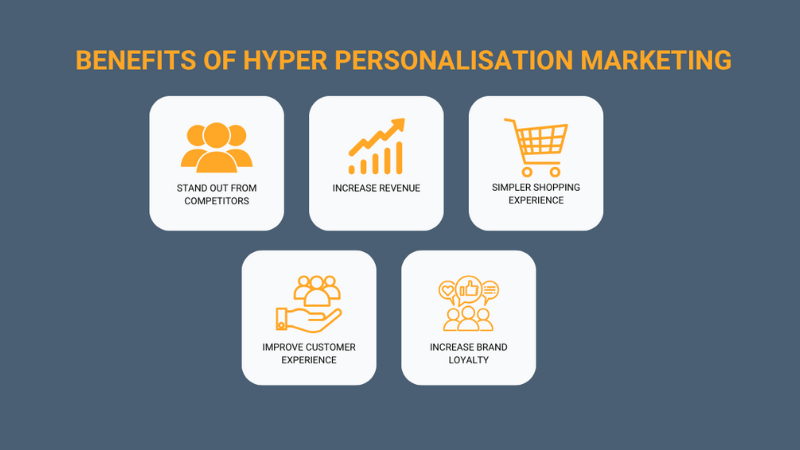Introduction:
In an era defined by digital transformation and evolving consumer expectations, hyper-personalisation has emerged as a critical differentiator for forward-thinking businesses.
This sophisticated approach represents a paradigm shift from traditional one-size-fits-all marketing to dynamic, data-driven customer experiences that adapt in real-time to individual preferences and behaviours.
By harnessing the combined power of advanced analytics, artificial intelligence, and machine learning, organisations can now process vast amounts of customer data to create uniquely tailored interactions at every touchpoint.
This level of personalisation extends far beyond simple name insertion or basic demographic targeting, enabling businesses to anticipate and fulfill customer needs before they’re even expressed.
Key Takeaways
- Enhanced Customer Experience: Tailored content makes interactions smooth and enjoyable.
- Boosted Revenue: Hyper-personalisation can increase income by up to 15%.
- Stronger Loyalty: Personalised services encourage repeat customers.
- Increased Referrals: Happy customers share their experiences, growing your audience.
- Better Marketing ROI: Focused strategies improve the effectiveness of your campaigns.
- Optimised Resources: Allocate efforts where they matter most.
Table of Contents
Hyper personalisation offers several key benefits for businesses:
1 Enhanced Customer Experience: Tailored interactions and content, reduce irrelevant messaging and make brand communications more impactful, resulting in a smoother and more enjoyable customer journey.
2 Increased Revenue and Conversions: Hyper personalisation can lead to a 10-15% revenue increase across sectors, with fast-growing companies deriving 40% more income from this tactic compared to competitors. It also results in higher conversion rates, as nearly 60% of business leaders consider personalization an effective strategy for acquiring new customers and increasing client lifetime value.
3 Improved Customer Retention and Loyalty: Personalised experiences create a sense of being understood and valued, leading to stronger emotional connections. 78% of consumers are more likely to make repeat purchases from companies that personalise.
4 Better Customer Engagement: When customers receive content and offers tailored specifically to them, they are more likely to engage with the brand and its products or services.

5 Increased Customer Referrals: Customers are 78% more likely to recommend a company to friends and family when it provides personalised experiences, driving new business and enhancing the brand’s reputation.
6 Improved Marketing ROI: By delivering targeted messages that connect with each customer on a personal level, hyper personalisation ensures marketing resources are used more effectively, yielding better results.
7 Better Resource Allocation: Hyper personalisation allows businesses to optimize their marketing efforts by focusing on the most relevant and effective strategies for each customer segment.
Implementation Considerations
The journey toward effective hyper-personalisation requires careful planning and a robust technological foundation. Organisations must first ensure they have the necessary data infrastructure to collect, process, and analyse customer information ethically and securely.
This includes implementing sophisticated customer data platforms (CDPs), investing in AI and ML capabilities, and developing clear data governance frameworks that prioritize privacy and compliance with regulatory requirements.
Success in hyper-personalisation also demands a cultural shift within organisations. Teams must break down traditional silos between marketing, sales, and customer service departments to create a unified view of the customer journey.
This collaborative approach enables the seamless flow of customer insights across departments, ensuring consistent and personalised experiences at every interaction point.
FAQ’s
Q: What is hyper personalisation?
A: It is a marketing strategy that uses data, AI, and machine learning to deliver highly tailored experiences to customers based on their preferences, behaviours, and needs.
Q: How does hyper-personalisation improve customer loyalty?
A: By making customers feel understood and valued through personalised interactions, businesses build stronger emotional connections, encouraging repeat purchases and long-term loyalty.
Q: Is hyper-personalisation only for large businesses?
A: No, businesses of all sizes can adopt hyper personalisation by starting with simple tools and gradually integrating advanced technology as they grow.
Final Thoughts
Hyper personalisation is not just a trend, but a fundamental shift in how businesses approach customer relationships. As technology continues to evolve and consumers demand more tailored experiences, companies that invest in sophisticated personalisation strategies will gain a significant competitive advantage.
Speak soon
Len
- Standard Operating Procedures: Your Ultimate Guide to Streamlining Business Efficiency - September 5, 2025
- Brutal Truth: Your Customer Perception Is Sabotaging Your Success (Here’s The Proof) - July 25, 2025
- The Counter-Intuitive Customer-Centric Culture Strategy That Changes Everything - July 11, 2025
